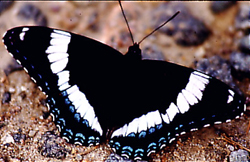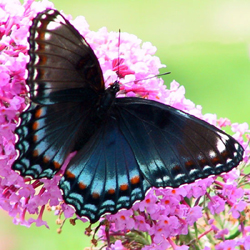Butterfly Atlas
Find a Butterfly
Red Spotted Purple / White Admiral
Limenitis arthemis
Named
Fabricius/Drury, 1775 /1773

Taxonomy & Nomenclature
The name Red-spotted Admiral has some currency.
Identification
Wingspan: Red Spotted Purple 3-3 3/8"; White Admiral 2 7/8-3 1/8". The two forms of Limenitis arthemis have strikingly different appearances. The Red-spotted Purple most closely resembles our dark swallowtails but is tailless, with no yellow or orange on the upperwing surfaces and red orange markings at the base and all along the outer margins of both underwings. The White Admiral is unmistakable, with a wide white band across all wings, above and below. Intermediates occur with greater or lesser extent of white banding.
Distribution
The species occurs from central Alaska across northern Canada to Newfoundland and Labrador; south, east of the Rocky Mountains, to central Mexico and the Gulf States. The Red-spotted Purple occupies the Southwest, Midwest, and East, north to central New England; the White Admiral flies throughout Canada and the northern tier of states. A "blend zone," where both subspecies and their intergrades occur, exists between about 40° and 46° N., from southern Minnesota east to New England.
Status in Massachusetts
The status of this species in Massachusetts has changed little from Scudder‘s day to the present. The White Admiral occupies the western uplands and is quite common most years in our four westernmost counties. It occurs sporadically and always in very small numbers in eastern Massachusetts. The Red-spotted Purple occurs statewide, being generally common, except in southeastern Massachusetts, where it is rare on Cape Cod and fairly common on Martha‘s Vineyard. On Nantucket, where it was previously unrecorded, it was found at five sites by Atlas workers, 1987 1989. Hybrid, or intermediate forms (with partial white banding) occur throughout the state, but are most frequent in the western portions. An eleven year survey of populations in Shutesbury (Franklin Co.) by Austin P. Platt found that of 1166 specimens examined, 42% of the individuals were partially banded (intergrades), 40% were unbanded (Red spotted Purples), and 18% were banded (White Admirals), (Platt, 1983).
Most often found singly or in small numbers in Massachusetts. Occasionally, and at selected sites, they may be more abundant. Maxima: Red-spotted Purple: 73, Monroe (Franklin Co.), 30 June 1995; White Admiral: 83, Monroe (Franklin Co.), 30 June 1995.
The species is subject to marked population fluctuations from year to year.

Flight Period in Massachusetts
The flight dates for Red-spotted Purple and White Admiral are very similar in Massachusetts. Adults typically fly from mid June to early August, with a partial second brood flying from mid August to mid September, a little later in the Red spotted Purple. Extreme dates: Red-Spotted Purple: 14 May 1987, Middleboro (Plymouth Co.), K. Holmes and 1 October 1988, West Stockbridge (Berkshire Co.), E. Dunbar. White Admiral: May 1991 (Essex Co.), J. McDougall and 15 September 1994, Rowe (Franklin Co.) D. Potter.
Larval Food Plants
Red spotted Purples feed most frequently on cherries, including Black Cherry (Prunus serotina), Pin Cherry (P. pennsylvanica), and Chokecherry (P. virginiana), but also utilize apples (Malus, sp.), plums (Prunus, sp.), hawthorns (Crataegus, sp.), hornbeams (Carpinus, sp.) Quaking Aspen (Populus tremuloides), Bigtooth Aspen (P. grandidentata), Eastern Cottonwood (P. deltoides), White Poplar (P. alba), Black Oak (Quercus velutina), Scrub Oak (Q.ilicifolia), gooseberry (Ribes, sp.), Deerberry (Vaccinium stamineum), and possibly willows (Salix, sp.).
White Admiral larvae prefer Sweet Birch (Betula lenta), Yellow Birch (B. alleghaniensis), and aspens (Populus, sp.), and also feed on American Basswood (Tilia americana), American Hornbeam (Carpinus caroliniana), hawthorns (Crataegus, sp.), and shadbushes (Amelanchier, sp.).
Adult Food sources
Both forms feed primarily at rotting fruit, sap, and animal droppings, and visit flowers infrequently. Opler and Krizek (1984) state that Red spotted Purples usually visit woody plants with small white flowers. They have been observed at 11 species in Massachusetts, including Daisy Fleabane, Joe Pye Weed, Catnip, Meadowsweet, Silky Dogwood, and Maleberry. White Admirals are known to take aphid honeydew.

Habitat
White Admirals prefer deciduous woodland roads and glades, while Red-spotted Purples occur here and to a considerable extent in more open situations, including meadow edges and shrub thickets.
Life Cycle
EGG: Gray green; dome shaped, with vertical ribs and fine horizontal lines. OVIPOSITION: Eggs laid singly, on upper surface of host plant leaf tip. LARVA: Brown or greenish, with whitish mid section; two short branched "horns". CHRYSALIS: Very similar to Viceroy; brown and white mottled and resembling a bird dropping.
The caterpillar emerges from its hibernaculum in late April and feeds for several weeks on sprouting host plant foliage. Pupation lasts from 12 14 days and adults are typically on the wing in mid June, continuing their emergence into July, and flying until August. Adults of both the White Admiral and Red-spotted Purple are fond of perching on branches and tree foliage (White Admirals may perch especially high in trees), and it is here that males seek out and mate with females.
Most of the offspring of the summer brood feed until half grown and then hibernate in a hibernaculum (similar to that of the Viceroy). A minority, however, develop fully during the summer of their birth, pupate, and emerge as a small, secondary brood in late summer. Butterflies from this late season brood may have a chance to mate in time for their offspring to develop into overwintering larvae (most Red spotted Purples) or time and cold weather may work against their survival (most White Admirals). (Scudder, 1889).
Notes
The Redspotted Purple is a mimic of the distasteful Pipevine Swallowtail, which reach their northern limits at approximately the same latitude. Red-spotted Purples mimic the model Pipevine Swallowtail in coloration and in flight, with low amplitude wing flapping and gliding. White Admirals gain a measure of protection from an altogether different device. The bold white banding on their wings helps break up the outline of the insect and is an example of disruptive coloration.
Account Author
Brian Cassie



